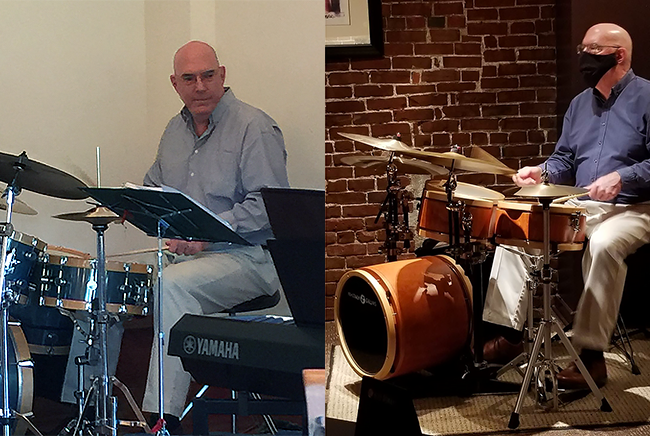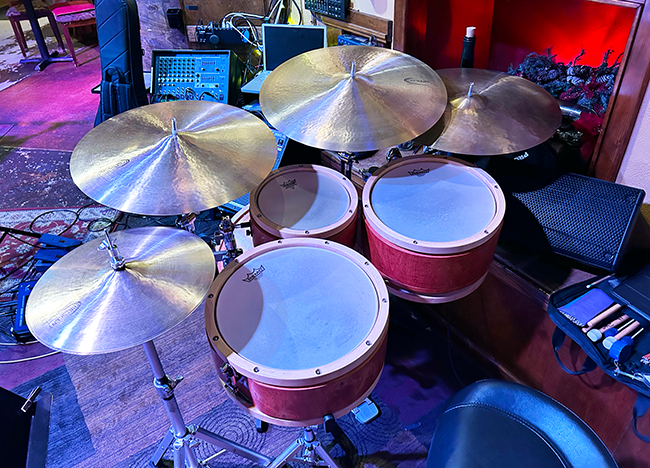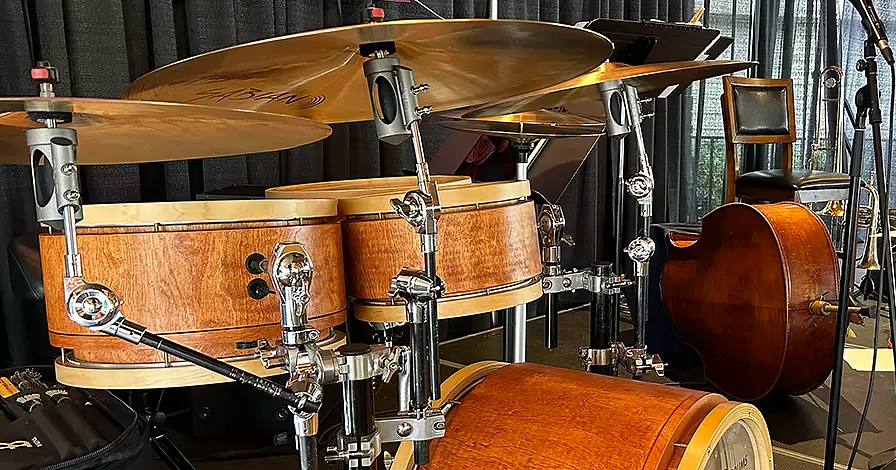The Ergonomic Flexibility of Whitney Drums
I stand at a height that’s just shy of six feet, four inches (193.04 cm), and one of the challenges I’ve had with playing drum sets is that standard drumset hardware frequently comes up short for me. Whitney Drums are the first drum kits I’ve ever owned that allow me to achieve a more healthy ergonomic setup.
 photos taken 2015 and 2021
photos taken 2015 and 2021
I’ve long been intrigued by the ergonomics of drumming. One of my earliest observations of the best jazz drummers was just how easy they made things look, how effortlessly they moved around the kit, and how refined every movement was. For the most part, the smoother the drummer looked, the smoother they sounded. The smoothest drummers frequently have a very ergonomic setup that I couldn’t achieve before owning Whitney Drums.
The photo on the left shows me playing my custom-made drums in 2015. Like many drum kits, its hardware limited the overall height of the drums. With some kits, I’ve played, the hi-hat or snare stand might not extend high enough, but more often its the post in the bass drum that supports the toms, or, as is the case with the kit on the left, the legs of the floor-tom aren’t long enough. That kit was built for me, so it had non-standard, extra-long legs with two-inch tall rubber foot extensions, yet it was still not high enough. To level “the playing field”, the throne/seat, snare, and small tom were all lowered down to accommodate the max height of the floor tom.
For a point of reference, my setup of the snare and two toms in the photo on the left is already about 3 inches (8cm) higher than an average-height drummer’s will be. At that height, the tops of my legs are level with the floor and the snare drum head is just barely above, meaning that my legs will at times get in the way of my hands and that my wrists and arms are at an angle that slightly limits a full range of motion. I’m also sitting a little too close to the bass drum, kind of leaning forward over the kit (a habit related to too many rack-tom mounting posts being set in the center or back of a bass drum) which has me wanting to play the pedals with more weight on my toes rather than balanced between my toes and heels. It also requires my knees to bend a little too far which puts pressure on them while playing and can encourage knee pain after decades of playing.
The photo on the right shows me playing one of my Whitney Drums kits. My throne/seat is now 3 inches (8cm) higher than with the older kit, and that puts the tops of my leg at a slightly downward angle to the floor. The snare and toms are now back from the bass drum a bit and this lets my longer legs have a slight outward bend that takes some of the tension off my knees. It also puts my ankles in a position where they have more range of motion and this has allowed me a little more finesse with my bass drum playing. The “playing field” of the snare and two toms is now about 3 inches (8cm) higher than the previous kit would allow and 6+ inches (15em+) higher than an average-height drummer will set up. That said, it looks “normal” (outside of me wearing a mask due to a global pandemic at the time the photo was taken) and if you saw the photo out of context, you might not realize just how high the kit is set up or how tall the drummer is. The lowest point of my snare and large tom heads are over 29 inches (74cm) off the floor.

The other piece of the ergonomic puzzle I introduced to the new setup was placing the toms on a level playing field with the snare and setting the three drums up like marching tri-toms. I think that most drummers and drum kits are designed and set up for traditional grip players, but I’ve been a matched grip player since day one, so this positioning/configuration makes more sense to me. The only challenge to this setup (other than 4 decades of muscle memory to unlearn) is that cross-sticking may hit the small tom rim, so I adjust the snare height about a quarter inch higher than the small tom. You can see that in the image below.

After over 40 years of playing drum sets professionally, I finally have an ergonomic approach to this instrument that rivals my peers. While it took over two years for me to get used to this new setup, the results are well worth the effort and I can hear the positive difference in my playing.
As someone who has heard you transition from a plateau (a very good place you were) to the wonderful sound and resulting sensitive player you have become, I’m impressed by the determination you have to take what you have and push yourself to the next level, into and thru the next challenge, and to share your gift to help others develop and grow!
I’m honored to be able to watch and hear this happen “live”! ~ Gary Bong